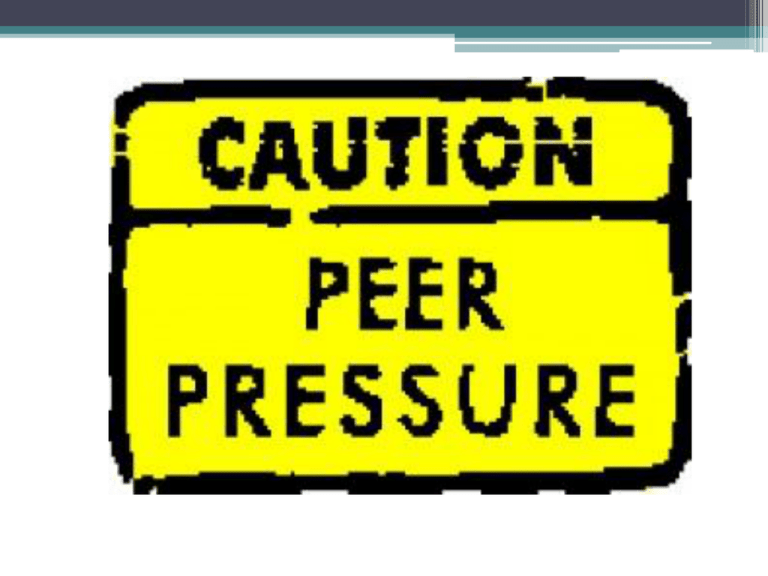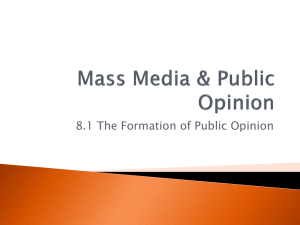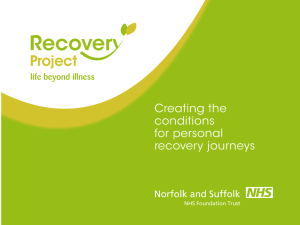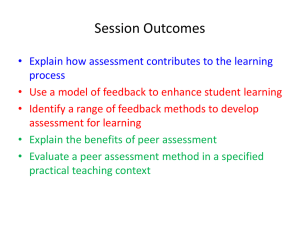What is Peer Pressure?
advertisement

What is Peer Pressure? • Pressure from one's peers to behave in a manner similar or acceptable to them. • Peer pressure is the influence of a social group on an individual. Think…. • What forms does peer pressure take? ▫ Good vs. Bad? • Why do people give in to peer pressure? • What feelings can result from being pressured? Why does bad peer pressure exist? • Peers who pressure you to make wrong decisions often want support for their wrong actions • People want to be accepted, even if it is for all the wrong reasons • It can give a false sense of belonging What to do…. 1. Recognize the TYPE of pressure trick 2. Decide the best way to RESPOND Peer Pressure Tricks: Spoken • Rejection: Threatening to end a friendship or a relationship. This pressure can be hard to resist because nobody wants to lose friends. Peer Pressure Tricks: Spoken • Put Downs: Insulting or calling a person names to make them feel bad. Peer Pressure Tricks: Spoken • Reasoning: Telling a person reasons why they should try something or why it would be OK if they did. (Nobody said these were good reasons.) Peer Pressure Tricks: Unspoken • Unspoken Pressure: This is something you feel without anyone saying anything to you. You feel unspoken pressure if you want to do the same things others doing. ▫ Continued on next slide…. Peer Pressure Tricks: Unspoken • A group of kids standing together in which everyone is talking and maybe looking at something you can't see, laughing and joking. Peer Pressure Tricks: Unspoken • Kids who think they're cool give you a certain look that means we're cool and you're not. Peer Pressure Tricks: Unspoken • A group of popular kids decide to get the same backpack and you want one too. Go to this website to test your knowledge of the different types of peer pressure. You have to understand them to avoid them!!! http://thecoolspot.gov/p eer_pressure5.asp Peer Pressure The Right to Resist! • If someone is pressuring you to do something, you have the right to say no, the right not to give a reason why, and the right to just walk away from a situation. Know your No’s: Least Effective • Passive: Use a thin or small voice, mumble, make excuses, use weak body language • Why is this an ineffective way? Know your No’s: Least Effective • Aggressive: Act pushy or angry, be loud, threaten or blame, use put-downs, and get in-your-face with the other person • Why is this an ineffective way? Know your No’s: Not Very Effective • Avoiding: Change the subject, avoid the issue, try to distract the other person ▫ *Could work in some situations, but it is still not best b/c they won’t see how you stand on the issue ▫ In what situations do you think this will work? Know your No’s: Not Very Effective • Know-it-all: Throw out facts, act superior, be judgmental, tell others how they are feeling, and get personal and off topic with the other person ▫ Could work in some situations (i.e. w/ family) • Why is this not the best way? Know your No’s: Most Effective!!! • Assertive: Stand up straight, look the other person in the eye, use a firm voice, speak quickly and politely, use well-chosen, definitive words (“No, I don’t want to”)—and don’t accept a “drink.” ▫ YEAH!!!!!!!!!!!! • Why is this the most effective? Go to this website to test your knowledge of the different ways to resist pressure. Some are effective, some are not!!! http://thecoolspot. gov/right3.asp Wrap Up • The key to dealing with negative peer pressure is self-confidence. • Be yourself, make your own decisions, regardless of what others think. • Listen to your gut • Learn to feel comfortable saying "no." Wrap Up • Hang with people who feel the same way you do. • If a situation seems dangerous, don't hesitate to get an adult's help. • If you can’t get the words out….walk away!!!!





